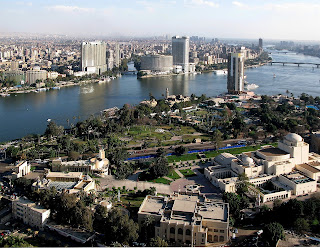I had put aside Wednesday and Thursday, May 23rd
and 24th, for grading my students’ final work; not coincidentally,
these were the election days for Egypt’s first open presidential election. Many
workplaces closed or shortened hours (we gave Nagat Wednesday off) so people
could vote; as the photo suggests, polling places often had long lines. Emad,
in his role as my local informant, promised to call if there were anything I
needed to know. When we spoke, the news so far was all good. People waited
patiently.
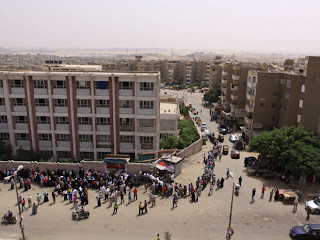 |
| Lines at polling stations (internet photo) |
It looks like the election results are less than what our
friends had hoped. The two candidates with the most votes (around 24% each) are
less than ideal from our friends’ perspectives. Morsi stands for the Muslim
Brotherhood and is conservative religiously and ideologically; Shafiq is a
holdover from the Mubarek regime. As one columnist wrote, it’s a choice between
shades of bad, and no one’s sure which is which. Malesh.
Saturday was special. Jimmy Carter has been in town for the
elections, and he spoke at at the Cairo Opera House, sponsored by AUC, Saturday
evening. Security was tight, no surprise; to get passes, both of us had to
apply and be vetted by American security. Though Carter’s speech started at
6PM, we had to be inside no later than 5:15. Harris joked (quietly) that he was
sure the Secret Service agents were secretly wishing they were in Cartagena….
Carter is the real deal, whose heartfelt beliefs in peace
and peaceful processes come from a combination of intellect and deeply felt
faith. He spoke with only an outline for half an hour, then spent half an hour
taking questions from three AUC students who represented the student body. We
were impressed by his idealism about Egypt’s future—may he be right, despite
the election results—and also by his frankness. For example, he bluntly said a
number of times how Israel had not held up their end of the Camp David
agreement by offering peace with the Palestinians. This got applause every time
he mentioned Palestinian freedom, including from us.
 |
| Carter speaking |
 |
| Carter talking with AUC students |
Afterwards, a group of us—including our buddy Chris
Evens—went to dinner at a famed Lebanese restaurant, Taboula, nestled in Garden
City near the Canadian Embassy. One of our table, a Cairo resident studying
Arabic, ordered for us, and the serious of non-stop appetizers added up to a
huge meal. The Lazy Susan featured in the center of the table was very handy.
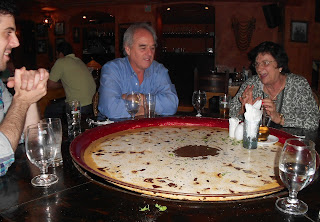 |
| Chris Evens and friends at Taboula |
 |
| Harris at Taboula |
Sunday was our chance to host three AUC students, Habiba
Koura, Shadden Fahmy, and Farida Swelim (Tarek’s daughter). Habiba and Shadden
were students both fall and spring terms, and we met Farida thanks to Tarek; in
addition, Shadden and Farida are cousins. The girls were a blast to have over
for our last party before the alabaster got packed up. Nagat made moussaka (of
course) and baba ganoush, I made salad, and the girls brought a mousse cake
for dessert. Yummy!
Of course, the necessities must be tended to prior to
departure, including hair and nails.
 |
| Preen we must! |
I have also been compiling a list for Customs once we reach
JFK. Everything we bought here to bring back must be declared. Duty will be
paid, I am sure. While I got my hair done, Harris supervised the pros from
International Express, who packed and are shipping our alabaster lamps door to
door. We are paying for the service but not having to go to JFK and spend the
day at Customs is worth it. The flat now looks very bare.
 |
| The nearly-empty apartment and its lazy occupant |
 |
| No alabaster lamps |
It’s also really hot, which makes laundry dry fast but keeps
us indoors if possible.
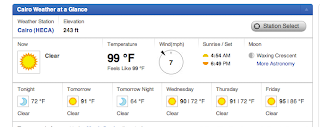 |
| 99 degrees |
Monday was scheduled to be our last event of this year in
Egypt, a reception and concert in honor of departing director of the Binational
Fulbright Commission, our friend Bruce Lohof and his wife Annemarie. It was
held at AUC’s Tahrir campus; as we inched our way through traffic, getting
later and later, it turned out that a demonstration was heating up in Tahrir
Square (right next to the AUC buildings), protesting the election results.
Given the absolute low numbers of the top two candidates,
Shafiq and Morsi, one can infer they were hardly the popular choices, and the
youth of Cairo agreed. They demonstrated against both, preferring a more
liberal candidate Sabbahi, who won in Cairo and Alexandria. Harris and I chose
the safest path, and Emad turned the car around and we ended up securely in
Ma’adi. It turned out that the protesters set fire to Shafiq’s campaign
headquarters about an hour after we returned to Ma’adi, so it was probably a
good thing to avoid the area.
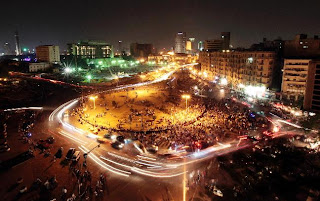 |
| Protest in Tahrir, 28 May (internet photo) |
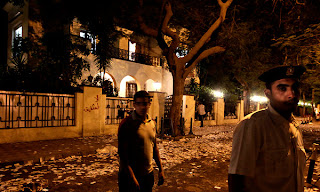 |
| Shafiq's HQ guarded after being burned (internet) |
 |
| At least we got to spend time with Amira and Emad even though we never made it to Fulbright |
However, it made both of us sad not to bid farewell to so
many with whom we have had a good year (with a leavening of politics). Insha’allah, British Airways will be
doing business as usual Sunday morning and our flight will depart safely.
We are emptying out the flat, spending evenings with Sarah
and Mark for last visits.
 |
| Harris, Mark, and Sarah in their apartment |
Since our cars at home need license plates and registration,
not to mention getting started, we will drive a rental car until that process
is done. I can hardly imagine driving, particularly where people drive in the
lanes, don’t drive the wrong way on one-way streets, and stop for lights and
stop signs. We suspect we will be ticketed for jaywalking and erratic driving…
We lose internet in our flat on May 31, so this will be my
last posting until we return and settle into New Haven. Call if you need me!
+20-2-2516-6514; my US phone is 1-203-776-5736; or Skype name “melprof” once I
am back stateside. Rather than say goodbye to Egypt, we say au revoir. Until the next time.
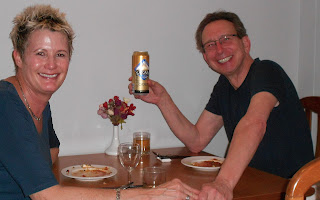 |
| Another dinner at China Winds |
 |
| The heat does bring out the flowers |
 |
| Anyone know what these trees are called? They are blooming like crazy. |
PS: I’ve pasted in a document I wrote over time here, “Mel’s
Cairo Tips,” for any of you planning a move here!
Mel McCombie’s Cairo Tips
Bring only comfortable shoes that you can wash. They will
wear out. No need to bring shoe polish since it’s available everywhere. Maybe
one pair of medium heels at most. Dedicate a toothbrush or nail brush to
washing your shoes, and put sneakers in the wash from time to time. Sandals are
not very useful since Cairo is so dirty. One pair of flip flops does it for me.
Bring cheap clothing since it will wear out (it has to be
washed after each wearing); wash with a good brand like Woolite detergent since
Persil, the local brand, is really harsh. Dress up your clothes with nice
scarves, etc.. Easier than crying as your favorite clothing falls apart. I
brought four good quality handbags and that worked well. Underwear and socks
wear out fast, from use and sweat, so bring extras.
Winter is colder than you think. Bring a wind-proof coat, a
couple of sweaters, etc..
You can’t get good cotton sheets here unless you pay a
fortune. Buy Kirkland brand at Costco or whatever you like; don’t worry that
the sizes are different, you can make a US king fit a local king. Pad your bags
with down pillows. They don’t exist here for love or money. If you need a
mattress pad, MasterBed (all over the city) has memory foam pads for about
$450. Amortize that against a night in a good hotel with a comfortable bed. Or
buy a cheap egg crate-style foam pad and pad your bag with that (or two twin
ones).
Cosmetics are expensive and selection poor. Bring your
favorite stuff. Don’t bother with shampoo, body lotion, toothpaste, etc. since
the basics are all here. Bring insect repellent, particularly for felucca rides
on the Nile. Lots of mosquitoes.
If you bring a printer, bring LOTS of ink cartridges. They
are expensive here and often not even available. Sizes of US and African
cartridges by the same company are often different.
Mini-Maglites are fabulous for tombs, dark uneven streets,
and closets. I keep mine on my keychain and carry another small flashlight in
my bag. LED works best. Batteries are available all over Egypt.
Bring some personal stationary; checks and deposit slips;
and US postage stamps. You can send mail through AUC’s faculty services offices,
or see if someone is headed to the US to carry it for you.
Always carry water.
Bring a good backpack. You’ll need one and a regular
Jansport costs about $100 in Cairo.
Buy wine and beer from Cheers, not Drinkies. It’s cheaper
and they have a great selection. Tel. is 19131, and they deliver everywhere. I
particularly like the wines from Jardin du Nil (organic) and Caspar.
You can get great coffee roasted and ground to order from
Shaheen Café. They are in Mohandiseen but deliver all over on various days. We
get French roast, filter drip grind, but you can get exactly what you like.
Tel: 19180.
If you live in Ma’adi, I think the best cleaners are
Victoria Clean. Tel. 2521-4547.
Gourmet Egypt (gourmetegypt.com) is a lifesaver. The only
really decent meats we found, really good frozen salmon and shrimp, good
organic veggies.
Otlob.com is a restaurant site that offers almost
everything. We like The Roastery and Abou El Sid best, but they have everything
and deliver everywhere.
My favorite stores: Markaz in Ma’adi, Road 199 at 233, for
gorgeous handmade scarves, table linens, quilts and coverlets, decorative
pillows, and lots of other stuff. The profits go mostly to the co-ops in Upper
Egypt that make the stuff. Also love Luxor Alabaster, where we have bought lots
of big alabaster lamps and a zillion tea lights. Great gifts. Road 231 in
Ma’adi, other locations around the city. In the Khan, beautiful scarves and
linens at Atlas Silks (near the Naguid Mahfouz Café).
The best driver and smartest man in Cairo is our driver,
Emad Hussein. He lives in Ma’adi and never gets lost (he is busy and will only
work with you if you live in Ma’adi). Emad’s number is 0122-379-3603. Pay him
at least LE50 per hour including waiting time. He will pick up your mail, get
you to and from the airport, fix your glasses, etc.. He’s known amongst those
who work with him as “Omda” (the Mayor). He is always early, not just on time.
We also heard from friends about another driver, Mohammed;
tel. 0106-866-2867
Hoard small bills for tipping and get a Ziplock or mesh
zipped bag to carry your cash. American wallets won’t work with the wads of
cash you need. If you bank locally, we have liked HSBC. Don’t go to the bank
(inside, not the ATM) on a Thursday since it’s very busy. You can get foreign
currency at the bank, which is helpful for travel.
Vodafone has the best cellular coverage. You can go to their
stores, or buy a cheaper phone at the many places with phones. We do pay as you
go, and it’s cheap. If you travel, get a Vodafone thingie for your computer so
you can get internet anywhere. Even Siwa.
Duty free is best at the airport, where you can buy 4
bottles of booze rather than 3 at the local duty frees. Do not buy
Egyptian-made distilled spirits; only buy imported. Stories abound.
I hate regular taxis, which is why we have a driver. It’s
been worth the money.
AUC Faculty Services has a listing of recommended
housekeepers. Contact Louise Saint Laurent at
louise@aucegypt.edu.
Gyms are expensive but helpful in keeping your sanity. I
like Samia Allouba. About $400 for a year.
If you are interested in scuba diving, contact me. I’m a
PADI Divemaster and we’ve dived all over the world and of course, the Red Sea.
It is MUCH colder than you think, so bring a 7mm wetsuit and a drysuit. And
hoods, gloves, etc..
Wash your produce—and your eggs--in a sink filled with water
with a big spoonful of regular Clorox added. It’s gross but there are so many
microorganisms that you will keep yourself healthy. After 15 minutes of
soaking, let your stuff air-dry. Take Lacteol Forte probiotic (available at all
pharmacies) and eat yogurt.
Don’t let your housekeeper wash your floors with Clorox.
Dettol is just as good and doesn’t bleach your sock soles.
Bring a coffee press, drip filter, or whatever you like
because it’s hard to buy them here—though buying paper filters is easy. Go
know.
Bring a knife sharpener and a decent knife. We got ours from
the Henkels line at Target, didn’t pay much, and are happy. If you can, bring a
cast iron skillet. Simply unavailable here and the best for searing meats.
Bring earplugs. Horns honk all the time, and since the
revolution, there’s a lot more street vending and noise.
Bring a camper’s water filter just in case. Bring a dozen
extra passport photos. Bring your original or certified marriage license if you
have different last names. VERY important. You can not get residency visas for
both of you unless you can prove you are married but have different last names.
Original or certified copy of your marriage certificate only.
Portable speakers to dock with an iPod are great. Ours were
battery powered and also worked with a power cord. They amplified sound while
watching streamed TV or movies on the computer and were great when traveling,
since we did not find any hotels with iPod docks.
There’s more street crime since the revolution so keep
alert, hold on to your bag on the side away from the street, and walk on
sidewalks if they exist.
Carry tissue packs with you for toilets (as well as one
pound coins), and use disinfecting wipes before you eat out. You can’t wash
your hands too often.
CSA (Community Services Association) in Ma’adi has great
trips, website, can organize custom tours, and offers a seminar for new
arrivals and is worth the money.
Bring dvds of your shows and movies. You can stream TV on
fastpasstv.ms sometimes, but often it messes up. If you belong to a Usenet, you
can download stuff to an external hard drive overnight. The Internet is often
the Inter-Not. My friends like Apple TV but it needs the internet.
Buy as many Euro Surge devices as you have electronics to
protect, Magellans.com and lots of other sites. The power often goes out and
when it comes back on, can blow fuses and melt hard drives.
Back up your computer 5 different ways, from the Cloud to
flash drives to external hard drives. You won’t be sorry, and if you don’t, you
will be sorry. We are Mac users, and you can’t get decent support here, so you
need to take extra precautions. Your back-up hard drive should be bootable in
case your internal hard drive develops a problem. If you bring your laptop, you
should also consider bringing a back-up power supply, the right DVI to VGA
adapter for presentations (AUC IT has them, but they can be a pain to get for a
specific occasion), and all the cables (USB, Firewire, Ethernet, iPod,
mini-plug audio, etc.) you can ever imagine using. Tech Tool Pro revived a
external hard drive that disk utilities couldn’t fix, so I would recommend
bringing a copy of your favorite drive utility app. You might want to bring a
220 V compatible printer/copier/scanner, but you can get them cheaply here and
sell them when you leave. Remember that you will need step-down (220 to 110)
voltage converters for all the 110-only devices you bring. (AUC provides one
1000 watt converter, but it has only one 110 outlet and is bulky.) You can buy
them here, but they are pricey.

















